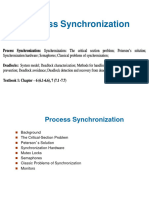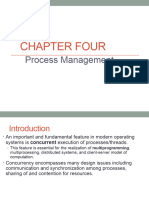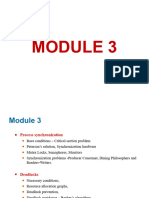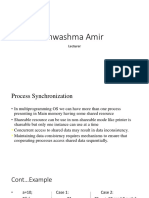0% found this document useful (0 votes)
33 views50 pagesProcess Synchronization
The document discusses various process synchronization problems including the Critical Section Problem, Mutex Locks, Semaphores, Bounded Buffering, Reader-Writer Problem, and the Dining Philosopher Problem. It explains the requirements for solving the Critical Section Problem, the differences between Mutex and Semaphores, and outlines the rules and solutions for the Reader-Writer and Dining Philosopher problems. The document emphasizes the importance of mutual exclusion and coordination in managing access to shared resources among concurrent processes.
Uploaded by
danghoangphuc2006Copyright
© © All Rights Reserved
We take content rights seriously. If you suspect this is your content, claim it here.
Available Formats
Download as PDF, TXT or read online on Scribd
0% found this document useful (0 votes)
33 views50 pagesProcess Synchronization
The document discusses various process synchronization problems including the Critical Section Problem, Mutex Locks, Semaphores, Bounded Buffering, Reader-Writer Problem, and the Dining Philosopher Problem. It explains the requirements for solving the Critical Section Problem, the differences between Mutex and Semaphores, and outlines the rules and solutions for the Reader-Writer and Dining Philosopher problems. The document emphasizes the importance of mutual exclusion and coordination in managing access to shared resources among concurrent processes.
Uploaded by
danghoangphuc2006Copyright
© © All Rights Reserved
We take content rights seriously. If you suspect this is your content, claim it here.
Available Formats
Download as PDF, TXT or read online on Scribd
/ 50
























































































